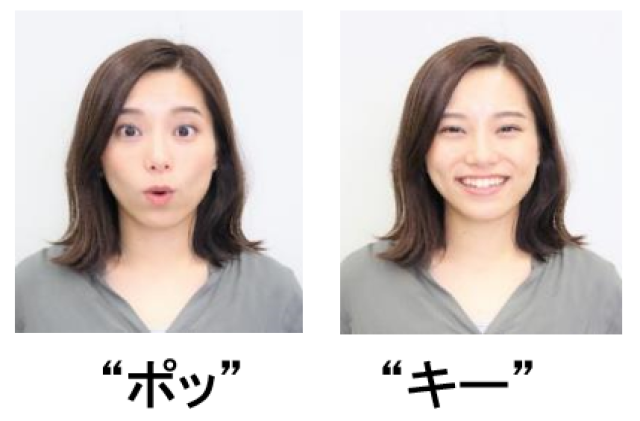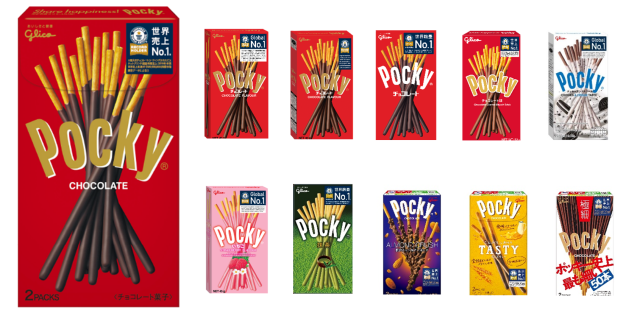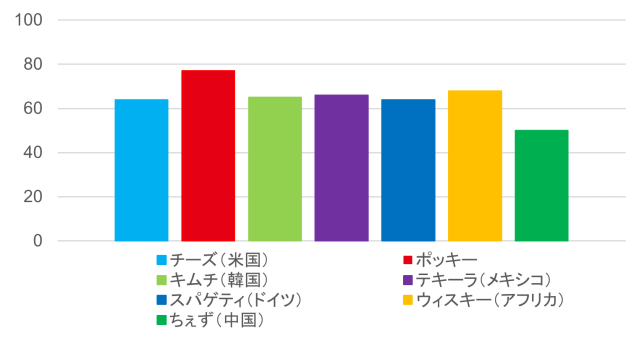
This 11 November, you can take your “cheese” and shove it.
As the leaves turn crimson red and the crisp scent of chilled air begins to emerge, it means only one thing in Japan. That’s right, another Pocky Day is fast upon us.
This holiday is celebrated every year on 11 November because the date written out as numerals looks like four Pocky sticks in a row, plus a kind of slanty one if you use a slash to write it. And the cookie-stick giant has a lot to celebrate this year in particular.
Last June Pocky earned another Guinness World Record as the “Largest Chocolate-Coated Biscuit Brand” for 2019. That year snack-maker Ezaki Glico moved a whopping US$589,900,000 in Pocky globally, eclipsing second-place Girl Scout cookies’ $324,100,000.
But money isn’t the only thing Pocky is good at generating. A recent study has shown that the brand’s name is more conducive to making people smile than other standard words that are shouted when photos are taken.
Under the guise of university research so as not to bias results, Ezaki Glico surveyed 200 students, asking them to subjectively gauge their own smiles while saying various words typically used among different cultures: cheese, kimchi, spaghetti, qiézi (Chinese for “eggplant”), Pocky, tequila, and whiskey.
The size of the smile that each word triggered was rated by the subject out of 100, and Pocky came in first over all with an average of 77 points, well above all the others which averaged in the 60s.
▼ Cheese (light blue), Pocky (red), kimchi (light green), tequila (purple), spaghetti (dark blue), whiskey (yellow), qiézi (dark green), all measured by their average smile ratings
To find out why this is, Ezaki Glico turned to leading Japanese smile researcher Toru Sugawara who said that saying “Pocky” is unique in that it also includes the “poh” sound (Pocky is meant to be pronounced with a long O sound, not a short A) which aids in achieving a “Duchenne smile.” This kind of smile involves using both the muscles which control the sides of one’s mouth as well as the muscles under one’s eyes, giving a much more sincere and natural sense of joy.
Duchenne smiles are difficult to fake because of the extra muscles involved and it is said that the average person can only pull it off on command 23 percent of the time. While most smile words’ “ee” sounds are good at activating the mouth muscles, saying “poh” and “kee” strengthens both the eye and mouth muscles respectively making a Duchenne smile all the more likely.
This is an Earth-shattering breakthrough that could have ramifications from online dating apps to school photo days, but Ezaki Glico is hoping you use this knowledge to help them ring in Pocky Day 2020 with their Say Pocky! Cheer Street View event.
This event is open to people in Japan, China, Hong Kong, Taiwan, Singapore, Thailand, Indonesia, Malaysia, Philippines, USA, and Canada and involves taking a selfie with a “Pocky” smile and pinning it to a location of your choosing on a dedicated version of Google Maps and Google Street View via the campaign website linked below. People can also participate as a team (teams appear as the same colored pin on the maps and street views) and the group with the most smiling photo pins will be displayed as a slideshow on the campaign’s website on Pocky Day. The images will appear framed in a digital replica of Osaka’s famous Glico sign landmark.
So, in those times when it pays to show those pearly whites, look past the mind-control refrigerators and Mr. Sato’s advice and just shout “Pocky!” Or, failing that, eating some Pocky probably wouldn’t hurt either.
Source: Say Pocky! Cheer Street View, PR Times
Images: PR Times
● Want to hear about SoraNews24’s latest articles as soon as they’re published? Follow us on Facebook and Twitter!






 Happy Pocky Day! Celebrate 11/11 with a fistful of Pocky sticks and these awesome tweets【Pics】
Happy Pocky Day! Celebrate 11/11 with a fistful of Pocky sticks and these awesome tweets【Pics】 Pocky x Street Fighter II collaboration comes with a special game for a limited time
Pocky x Street Fighter II collaboration comes with a special game for a limited time The battle over 11/11 is underway in Japan: Pocky vs every other business
The battle over 11/11 is underway in Japan: Pocky vs every other business Get a behind-the-scenes look at how Pocky is made in this short clip of the Glico factory 【Video】
Get a behind-the-scenes look at how Pocky is made in this short clip of the Glico factory 【Video】 It’s a cherry blossom party in your mouth with sakura matcha Pocky!
It’s a cherry blossom party in your mouth with sakura matcha Pocky! Japan’s new difficult-to-drink-from beer glass protects your liver, but it’s a brutal experience
Japan’s new difficult-to-drink-from beer glass protects your liver, but it’s a brutal experience Hello, cosmetics! Clinique teams up with Hello Kitty this summer for first-time collaboration
Hello, cosmetics! Clinique teams up with Hello Kitty this summer for first-time collaboration How to order snacks on a Shinkansen bullet train in Japan
How to order snacks on a Shinkansen bullet train in Japan Demon Slayer: Kimetsu no Yaiba gets new roller coaster attractions and food at Universal Studios Japan
Demon Slayer: Kimetsu no Yaiba gets new roller coaster attractions and food at Universal Studios Japan New samurai glasses are Japan’s latest weird must-have souvenir
New samurai glasses are Japan’s latest weird must-have souvenir Burger King Japan suddenly adds Dr. Pepper and Dr. Pepper floats to its menu nationwide
Burger King Japan suddenly adds Dr. Pepper and Dr. Pepper floats to its menu nationwide New Nintendo Lego kit is a beautiful piece of moving pixel art of Mario and Yoshi【Photos】
New Nintendo Lego kit is a beautiful piece of moving pixel art of Mario and Yoshi【Photos】 What do you eat when you catch a cold? We asked 11 of our Japanese reporters
What do you eat when you catch a cold? We asked 11 of our Japanese reporters High-fashion Totoro cuddle purse is like an elegant stroll in the forest【Photos】
High-fashion Totoro cuddle purse is like an elegant stroll in the forest【Photos】 Why Japanese doesn’t need swear words
Why Japanese doesn’t need swear words Nintendo history you can feel – Super NES, N64, and GameCube controllers become capsule toys
Nintendo history you can feel – Super NES, N64, and GameCube controllers become capsule toys “The most Delicious Cup Noodle in history” – Japan’s French Cup Noodle wins our heart【Taste test】
“The most Delicious Cup Noodle in history” – Japan’s French Cup Noodle wins our heart【Taste test】 Starbucks releases a cute Frappuccino and Unicorn Cake…but not in Japan
Starbucks releases a cute Frappuccino and Unicorn Cake…but not in Japan Kyoto Tower mascot termination reveals dark side behind cute Japanese characters
Kyoto Tower mascot termination reveals dark side behind cute Japanese characters McDonald’s Japan’s Soft Twist Tower: A phantom ice cream only sold at select branches
McDonald’s Japan’s Soft Twist Tower: A phantom ice cream only sold at select branches Yabai Ramen: What makes this Japanese ramen so dangerous?
Yabai Ramen: What makes this Japanese ramen so dangerous? Finally! Nintendo Japan expands Switch 8-bit controller sales to everybody, Online member or not
Finally! Nintendo Japan expands Switch 8-bit controller sales to everybody, Online member or not Japanese government wants to build luxury resorts in all national parks for foreign tourists
Japanese government wants to build luxury resorts in all national parks for foreign tourists To combat declining birth rate, Japan to begin offering “Breeding Visas” to foreigners
To combat declining birth rate, Japan to begin offering “Breeding Visas” to foreigners 10 things you should buy at 7-Eleven in Japan
10 things you should buy at 7-Eleven in Japan Studio Ghibli releases anime heroine cosplay dresses that are super comfy to wear
Studio Ghibli releases anime heroine cosplay dresses that are super comfy to wear Woman charged for driving suitcase without a license in Osaka
Woman charged for driving suitcase without a license in Osaka Studio Ghibli unveils My Neighbour Totoro miniature house model
Studio Ghibli unveils My Neighbour Totoro miniature house model Kyoto experiencing problems with foreign tourists not paying for bus fares, but not on purpose
Kyoto experiencing problems with foreign tourists not paying for bus fares, but not on purpose Fighting mild hunger with a Japanese soda that turns into jelly in the stomach【Taste test】
Fighting mild hunger with a Japanese soda that turns into jelly in the stomach【Taste test】 Studio Ghibli’s Howl’s Moving Castle tapestry unveiled in Japan for first time
Studio Ghibli’s Howl’s Moving Castle tapestry unveiled in Japan for first time McDonald’s new Happy Meals offer up cute and practical Sanrio lifestyle goods
McDonald’s new Happy Meals offer up cute and practical Sanrio lifestyle goods Sales of Japan’s most convenient train ticket/shopping payment cards suspended indefinitely
Sales of Japan’s most convenient train ticket/shopping payment cards suspended indefinitely Sold-out Studio Ghibli desktop humidifiers are back so Totoro can help you through the dry season
Sold-out Studio Ghibli desktop humidifiers are back so Totoro can help you through the dry season Japanese government to make first change to romanization spelling rules since the 1950s
Japanese government to make first change to romanization spelling rules since the 1950s Foreigner’s request for help in Tokyo makes us sad for the state of society
Foreigner’s request for help in Tokyo makes us sad for the state of society Ghibli founders Toshio Suzuki and Hayao Miyazaki contribute to Japanese whisky Totoro label design
Ghibli founders Toshio Suzuki and Hayao Miyazaki contribute to Japanese whisky Totoro label design Doraemon found buried at sea as scene from 1993 anime becomes real life【Photos】
Doraemon found buried at sea as scene from 1993 anime becomes real life【Photos】 Tokyo’s most famous Starbucks is closed
Tokyo’s most famous Starbucks is closed Princesses, fruits, and blacksmiths: Study reveals the 30 most unusual family names in Japan
Princesses, fruits, and blacksmiths: Study reveals the 30 most unusual family names in Japan Two guinea pigs accidentally find love sharing a snack on November 11th “Pocky Day” 【Video】
Two guinea pigs accidentally find love sharing a snack on November 11th “Pocky Day” 【Video】 Pocky gets elegantly mature with new flavor designed to be paired with red wine
Pocky gets elegantly mature with new flavor designed to be paired with red wine Pocky grows up with a special whiskey version of the beloved Japanese chocolate candy
Pocky grows up with a special whiskey version of the beloved Japanese chocolate candy New limited edition blue, heart-shaped Pocky designed for maximum happiness
New limited edition blue, heart-shaped Pocky designed for maximum happiness The luxurious new Bâton d’or La Recolte Pocky has us feeling fancy【Taste test】
The luxurious new Bâton d’or La Recolte Pocky has us feeling fancy【Taste test】 New matcha Pocky from Japan is a heavenly treat for green tea lovers
New matcha Pocky from Japan is a heavenly treat for green tea lovers Younger Japanese men less interested in drinking, according to survey
Younger Japanese men less interested in drinking, according to survey Happy Pocky Day! Japan celebrates with huge towers and crazy art featuring the beloved snack
Happy Pocky Day! Japan celebrates with huge towers and crazy art featuring the beloved snack Amazing ad from Japan stars 72 actresses each showing one year of a woman’s life in one second
Amazing ad from Japan stars 72 actresses each showing one year of a woman’s life in one second New Champagne Pocky available in Japan
New Champagne Pocky available in Japan McDonald’s Japan combines beloved beverages of adults and kids with new coffee milkshakes
McDonald’s Japan combines beloved beverages of adults and kids with new coffee milkshakes Combining the new Pocky and “Teagurt” brings you kisses and the taste of cheesecake
Combining the new Pocky and “Teagurt” brings you kisses and the taste of cheesecake Japanese temple puts up three messages of wisdom the Internet should take to heart
Japanese temple puts up three messages of wisdom the Internet should take to heart Japan’s favorite Pokémon types by prefecture–which types are the most popular?
Japan’s favorite Pokémon types by prefecture–which types are the most popular? 252 Pocky lovers gather in Shibuya to set a world record 【Video】
252 Pocky lovers gather in Shibuya to set a world record 【Video】
Leave a Reply